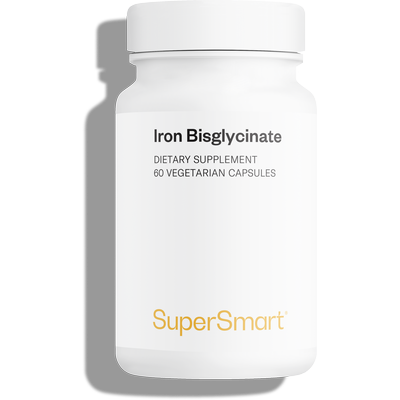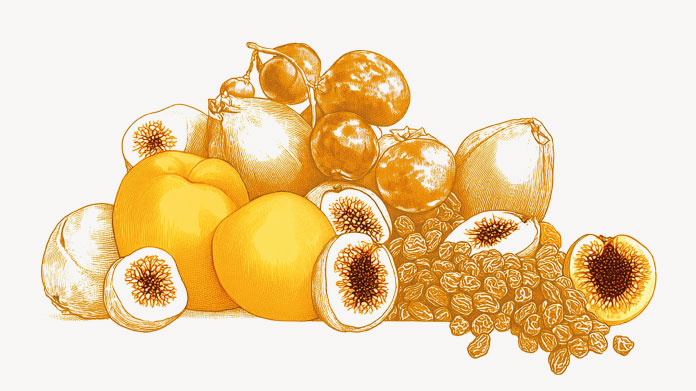
What is ferritin?
Ferritin: a protein that stores iron
Ferritin is a protein that is essential for the body to function properly.
It is responsible for storing iron and releasing it according to physiological needs.
It is found mainly in the liver, spleen, bone marrow and muscles, where it constitutes a strategic reserve of iron, a mineral essential for many biological processes, including oxygen transport and energy metabolism.
Ferritin levels
Ferritin levels are generally measured by a blood test.
It varies according to the person's age and sex.
In general, ‘normal’ levels are defined as between 20 and 400 ng/mL of blood in women, and between 30 and 400 ng/mL in men (1).
Hyperferritinaemia (high ferritin) may indicate iron overload or other pathologies: chronic inflammation, liver disease, metabolic syndrome, cancer, etc.
Hypoferritinaemia (low ferritin), on the other hand, may indicate an iron deficiency in the body's reserves (2). Hypoferritinaemia does not usually result from a defect in ferritin production, but rather a reduction in the body's iron reserves available for storage, which in turn leads to a drop in ferritin levels.
Low ferritin: symptoms, causes & solutions
Diagnosis and symptoms of hypoferritinaemia
Hypoferritinaemia is diagnosed when a blood test reveals a ferritin level of less than 20 to 30 ng/mL of blood.
This condition is often initially silent, but over time it leads to symptoms typical of iron deficiency (3):
- persistent fatigue
- pale complexion
- shortness of breath on exertion
- reduced concentration
- headaches
- hair loss and brittle hair
When hypoferritinaemia has been present for some time or worsens, it can develop into iron deficiency anaemia.
This is a form of anaemia caused by a lack of iron and characterised by a drop in haemoglobin levels in the blood.
Haemoglobin is a protein found in red blood cells, responsible for transporting oxygen from the lungs to the body's tissues. The iron it contains enables it to bind oxygen.
People at risk of low ferritin and common causes of this problem
Low ferritin can have several causes, generally linked to insufficient iron intake, excessive iron loss or poor iron absorption.
Some people are therefore more prone to hypoferritinaemia than others:
- women with heavy periods or haemorrhagic bleeding
- pregnant women, whose pregnancy tends to increase their iron requirements
- endurance athletes
- the elderly
- children and adolescents during their growth period
- people on a diet low in iron (unbalanced vegetarian or vegan diet, for example)
- patients suffering from certain chronic digestive disorders that impair iron absorption (coeliac disease, Crohn's disease, etc.)
- people who have undergone digestive surgery that may have altered their ability to absorb iron (gastric bypass, small intestine resection, etc.)
- people who have suffered haemorrhage or unidentified internal blood loss (digestive bleeding, for example)
- people who donate blood frequently
Solutions for correcting a ferritin deficiency
Make the right diagnosis
To correct low ferritin, it is essential to look for the underlying cause, in order to provide an appropriate response.
If the cause is a pathology or hidden haemorrhage, only your doctor will be able to advise you on the appropriate treatment.
On the other hand, if inadequate iron intake is to blame, one of the first steps to take is generally to increase dietary intake.
The best food sources of iron
Iron-rich foods can be of plant or animal origin.
However, meat is a source of haem iron, which is better absorbed by the human body (4): poultry or veal liver, black pudding, beef or lamb, sardines, mackerel, seafood, etc.
On the plant side, you can opt for legumes (lentils, kidney beans, etc.), tofu, spinach, pumpkin seeds or wholegrain cereals (quinoa, oat flakes, etc.), which contain non-haem iron.
To improve absorption of non-haem iron, ideally eat it with a source of vitamin C (orange juice, kiwi fruit, peppers, etc.) and avoid drinking tea or coffee immediately after a meal.
If eating iron-rich foods is not enough, or if you need more iron, you may consider taking iron-based food supplements, subject to medical approval.
Iron supplementation in cases of low ferritin
Iron supplements: only in cases of proven deficiency
Before taking an iron supplement, however, the deficiency must be clearly diagnosed by a doctor following a blood test.
Excess iron in the body can be a source of health problems if it lasts or is particularly high (oxidative stress, liver overload, etc.).
The most absorbable form of iron
Not all iron supplements are created equal.
Some forms of iron are better absorbed during digestion and therefore offer better bioavailability.
This is particularly true of iron bisglycinate (5), a chelated form that is gentle on the digestive system and has good bioavailability.
It is often better tolerated than ferrous sulphate, iron citrate or iron D-gluconate, which are known to cause numerous side effects.
![]() Discover the Iron Bisglycinate iron supplement, which contains a form of iron that is both well tolerated and well assimilated, ideal for correcting a deficiency gently and without side effects.
Discover the Iron Bisglycinate iron supplement, which contains a form of iron that is both well tolerated and well assimilated, ideal for correcting a deficiency gently and without side effects.
SUPERSMART ADVICE
References
- https://www.ameli.fr/assure/sante/themes/anemie-par-carence-en-fer/symptomes-diagnostic#:~:text=Le%20taux%20normal%20de%20ferritine,r%C3%A9v%C3%A8le%20une%20carence%20en%20fer.
- Caquet R. 250 examens de laboratoire. 250 Examens de Laboratoire. 2015:9–535. French. doi: 10.1016/B978-2-294-74458-7.00002-7. Epub 2015 Aug 15. PMCID: PMC7161405.
- Auerbach M, DeLoughery TG, Tirnauer JS. Iron Deficiency in Adults: A Review. 2025 May 27;333(20):1813-1823. doi: 10.1001/jama.2025.0452. PMID: 40159291.
- https://www.anses.fr/fr/content/tout-savoir-sur-le-fer
- Fischer JAJ, Cherian AM, Bone JN, Karakochuk CD. The effects of oral ferrous bisglycinate supplementation on hemoglobin and ferritin concentrations in adults and children: a systematic review and meta-analysis of randomized controlled trials. Nutr Rev. 2023 Jul 10;81(8):904-920. doi: 10.1093/nutrit/nuac106. PMID: 36728680; PMCID: PMC10331582.
2 Days
SUPERSMART WHAT ELSE👍
SUPERSMART WHAT ELSE👍
DIEDERLE Christophe
5 Days
Excellent quality products with…
Excellent quality products with innovative formulas, as someone who has been suffering with acid reflux, these supplements have been lifesavers.
Oriana Moniz
5 Days
high quality supplement!
high quality supplement!
GALANT
5 Days
Good service prompt delivery
Good service prompt delivery
Mrs Marcella Reeves
10 Days
I like your clear explanation
I like your clear explanation. And how to make a choice of products for a specific health problem
Ingrid
16 Days
Great product and it arrives quickly.
Great product and it arrives quickly.
SOMMARIVA Gianni
18 Days
Excellent products and fast service.
Excellent products and fast service. What do we need more?
Margarida
22 Days
The variety of products is amazing
The variety of products is amazing, the offers are good and the sending is very fast. I just miss having a bit more of guidance about combinations, possible interactions, etc.
Maria Angeles Verdu
23 Days
It was quick
It was quick.
Timo Antero
26 Days
Who is a good boy? You, you are! Yes, yes
:) :(:) :(:) :(:) :(
JORGE Catalan Gasco
28 Days
Excellent online site
Excellent online site, efficient and quick delivery. A great experience.
Chris
31 Days
I’m really happy with your products, but…
I’m really happy with your products. Indeed, I’ve been a customer of SuperSmart for a long time. However, I believe that lately you’ve made a significant mistake in choosing Poste Italiane for your deliveries. Poste Italiane is now over loaded and assigns the deliveries to small local companies that have grown like mushrooms because of this business. However, the service they provide is very poor. They let you know about the delivery date just the evening before, with no time to organize yourself, many times you receive a message saying that they tried to deliver but you were not home and in reality they haven’t come at all and, when they do come, you open the door of the building ( I live on the 3rd floor) and when you get downstairs they have already left, leaving the pack inside but right behind the glass door instead of at least putting it on top or under the letterbox. This is not just a one time event but it’s their way of proceeding. It would be worth hiring a professional currier. Thanks
Olga Gladys Del Signore
31 Days
Good products
Good products, fast service
Mrs I Heinrich
38 Days
Quality products and fast shipping.
Quality products and fast shipping.
JF
39 Days
Everything is great. Keep up
Your product and service is great that's why i ordered again.
KOSMATOS Stamatios




